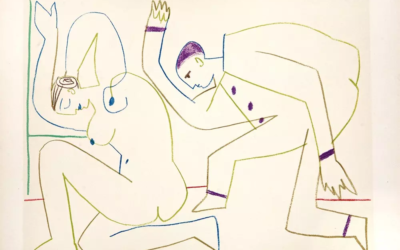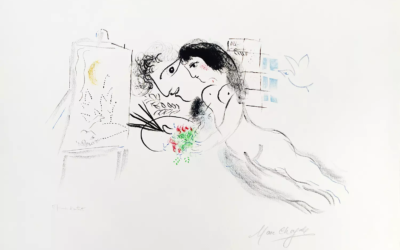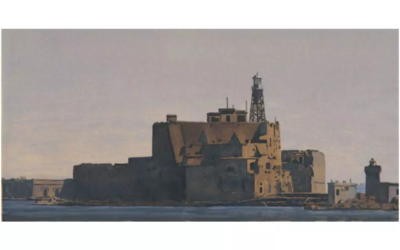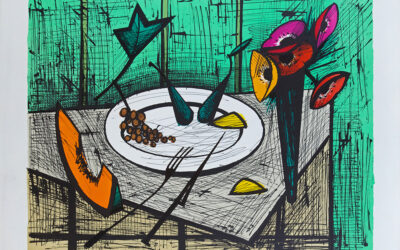
Qu’est-ce qu’une estampe : techniques et explications
De l’italien stampa (presse) et stampere (impression), le mot estampe partage sa racine avec le mot tampon. Ce n’est donc pas un hasard si le terme d’estampe désigne le résultat de l’impression d’une matrice (en pierre, en bois ou en métal) qui, après encrage, est pressée sur un support papier.
Le terme estampe est le mot générique pour désigner les œuvres réalisées grâce aux différentes techniques d’impression sur papier : la gravure (sur bois, pointe sèche, eau-forte, aquatinte, manière noire, vernis mou, linogravure, …), la lithographie, la sérigraphie.
Depuis son apparition, l’estampe joue un rôle majeur dans le monde de l’art. De grands noms tels que Picasso, Matisse ou Miró ont participé à populariser ce médium, plus accessible que les traditionnels tableaux.
Qu’est-ce qu’une estampe ? Quelles sont ses différentes techniques d’impression ?
Aux origines de l’estampe : l’Asie et l’Europe du Nord
La toute première estampe identifiée à ce jour nous vient de Chine.
Réalisée sous la dynastie Tang (618-907) grâce à une technique ancestrale de gravure sur bois (xylographie) l’œuvre s’inscrit dans un sutra religieux et représente Bouddha lui-même, priant sous un arbre.
En Asie, l’histoire de l’estampe est en effet intimement liée à celle du livre.
Si elle est à l’origine exclusivement réservée aux ouvrages pieux, l’estampe se démocratise dans d’autres types de traités et manuels sous la dynastie Song (960 et 1279) et son imagerie connaît une véritable diversification.
En effet, on y introduit des éléments naturels qui viennent illustrer les manuscrits mais aussi des divinités populaires ou des femmes dont on vient mettre en valeur la beauté. Très vite, le texte devient secondaire et l’image prime.
Côté Occident, c’est en Allemagne que l’estampe naît à la toute fin du XIVe siècle, un peu avant l’invention de l’imprimerie par Gutenberg.
Dans un premier temps, la technique de l’estampe permet de diffuser massivement des images (et donc, de l’information) à une population majoritairement illettrée. Si la technique employée au départ est celle de la gravure sur bois (portée par Albrecht Dürer) les orfèvres allemands popularisent la gravure sur métal (cuivre) au cours du XVe siècle.
Si les premières représentations imprimées sont principalement de nature pieuse ou politique, on ne tarde pas à détourner l’estampe pour produire des images profanes, comme des cartes à jouer.
Bien plus tard, à la fin du XIXe siècle, l’estampe se renouvelle et trouve une fonction commerciale et publicitaire. Toulouse-Lautrec en est le fer de lance, puisqu’il crée pas moins de 325 lithographies pour le Moulin Rouge entre 1891 et 1900.
Au XXe siècle, l’estampe a été un formidable outil d’expression et de diffusion pour les artistes modernes, aussi bien à travers la gravure que la lithographie. La plupart des grands artistes de la première moitié du siècle s’y sont essayés, certains nourrissant pour ce médium une vraie passion, à l’instar de Picasso, Miró ou Chagall.
Aujourd’hui, les estampes, aussi bien les lithographies que les gravures, sont très populaires auprès des collectionneurs, novices comme des amateurs.
Les différents types d’estampe et leurs techniques
La gravure sur bois et les procédés en relief : la taille d’épargne
Aussi appelée xylographie, la gravure sur bois est la technique la plus ancienne pour créer des estampes.
Ce procédé dit en taille d’épargne consiste à tailler une plaque de bois afin que les parties creusées constituent les blancs et que les parties en relief, “épargnées” par la main du graveur, constituent le motif qui sera imprimé. Les parties creuses du bois ne recevront pas l’encre contrairement aux parties en relief.
La linogravure est une autre technique de taille d’épargne, dont la matrice est une plaque de linoléum.
La gravure sur métal et les procédés en creux : la taille douce
À l’inverse de la taille d’épargne, cette technique consiste à graver des sillons dans une plaque de métal. L’encre appliquée pénètre alors les sillons pour y former les lignes du dessin. On presse ensuite le support d’impression directement sur la plaque.
La pointe sèche
La pointe sèche est une technique de gravure en taille-douce qui tient son nom de l’outil utilisé pour graver une plaque de métal, généralement en cuivre. Contrairement à la taille d’épargne, ce procédé consiste à inciser une matrice à l’aide d’une pointe sèche ou d’un burin (une lame d’acier coupée en biseau) pour que l’encre se dépose dans les incisions.
La pointe sèche est un outil pointu métallique qui se manie comme un crayon. La taille des incisions varie selon la taille de la pointe utilisée. Le burin quant à lui s’utilise à la manière d’une gouge pour creuser la matière.
Une fois la plaque gravée, elle est encrée puis imprimée.
L’eau forte
La technique de l’eau-forte remonte au XVe siècle et repose sur l’utilisation d’un composant chimique pour graver la plaque métallique. Si, à l’origine, les aquafortistes utilisaient l’acide nitrique pour mordre le métal, il a peu à peu été remplacé par des solutions moins toxiques telles que le perchlorure de fer ou le sulfate de cuivre.
Dans un premier temps, la plaque de métal est recouverte d’un vernis à graver sur lequel l’artiste vient dessiner à l’aide d’une pointe de métal. Une fois le dessin réalisé, la plaque est plongée dans un bain d’acide qui « mord » les zones gravées. La plaque est ensuite nettoyée, encrée et mise sous presse afin d’imprimer le motif sur le papier
L’aquatinte (ou aqua-teinte)
L’aquatinte est une technique d’eau forte qui consiste à graver une plaque de cuivre puis la placer dans une “boîte à grains” dans laquelle une fine couche de poudre de résine (colophane) va se déposer.
La résine est ensuite chauffée pour adhérer à la plaque et devient transparente. L’artiste vient ensuite protéger certaines zones avec du vernis avant de plonger la plaque dans un bain d’acide pour mordre le métal sur les zones non protégées par le vernis et entre les milliers de grains de poudre de résine, créant un rendu velouté.
Suivant le temps de morsure, la quantité de résine déposée, la taille du grain et le nombre d’applications successives, l’aquatinte permet d’obtenir de nombreuses nuances de gris, allant jusqu’au au noir. Elle permet également l’utilisation délicate de la couleur et des fondus proches du lavis ou de l’aquarelle. L’aquatinte est la technique utilisée dans la plupart des gravures en couleurs.
La lithographie : un procédé à plat
Inventée par Aloys Senefelder en 1796, la lithographie se fait à plat sur une épaisse pierre calcaire sur laquelle on dessine à l’aide d’un matériau gras, crayon ou encre.
Une fois le dessin terminé, le lithographe applique une solution de gomme arabique et d’acide sur la pierre pour y fixer le dessin. La pierre est alors humidifiée et encrée. La porosité du calcaire permet de retenir l’eau sur les parties non dessinées, tandis que l’encre grasse reste sur les parties dessinées.
L’impression se fait sous presse en posant le papier sur la pierre préalablement humectée et encrée. Une fois l’impression achevée, la lithographie est placée sur un séchoir.
Chaque couleur de la lithographie correspond à un dessin sur la pierre et à un passage sous la presse. Chaque couleur est dessinée et encrée soit sur la même pierre, soit sur une pierre différente. Une lithographie en 6 couleurs nécessitera donc 6 encrages et 6 impressions différentes, pour chaque feuille.
Vous êtes collectionneur ou amateur d’art ? La Galerie d’art à Paris, Arenthon, propose un vaste choix d’estampes (lithographies, eaux-fortes, sérigraphies…).





